|
|
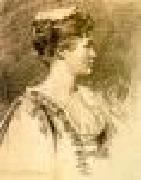 |
Beckwith James Carroll
|
|
American, 1852-1917
was an American portrait painter. He was born at Hannibal, Missouri, on 23 September 1852. He studied in the National Academy of Design, New York City, of which he afterwards became a member, and in Paris (1873-1878) under Carolus Duran. Returning to the United States in 1878, he gradually became a prominent figure in American art. He took an active part in the formation of The Fine Arts Society, and was president of the National Free Art League, which attempted to secure the repeal of the American duty on works of art. Among his portraits are those of William Merritt Chase (1882), Miss Jordan (1883), Mark Twain, Thomas Allibone Janvier, John Schofield and William Walton. He taught at the Art Students League of New York -- where Violet Oakley was one of his students |
|
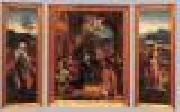 |
BEER, Jan de
|
|
Netherlandish Painter, ca.1475-1528
South Netherlandish painter and draughtsman. He is first mentioned in 1490 in the register of the Antwerp Guild of St Luke, apprenticed to the painter Gillis van Everen ( fl 1477-1513). In 1504 de Beer became a master. He subsequently served as alderman of the guild in 1509 and dean in 1515, although he found himself temperamentally unsuited to the position of dean, as is known from a lawsuit he filed in 1519 regarding guild administration. This document also reveals that de Beer participated in the preparations for Charles V's 'Joyous Entry' into Antwerp in 1515 and for the Antwerp Society of Rhetoricians' entry that year in the Malines landjuweel (regional competition of the rhetoricians). In 1510 and 1513 de Beer enrolled apprentices; his son Aert de Beer (c. 1509-before 6 Aug 1540) became an Antwerp master in 1529. The artist is undocumented between 1519 and 1528, by which date he was dead. In 1567 Guicciardini included de Beer in his list of famous Netherlandish painters. |
|
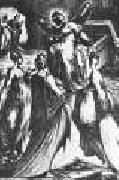 |
BELLANGE, Jacques
|
|
French Painter, ca.1575-1616
Jacques Bellange (c. 1575, place unknown - 1616) was an artist and printmaker from Lorraine, now in France, whose etchings and some drawings are his only securely identified works today. They are among the most striking Mannerist old master prints.
His known artistic activity dates only from 1602 to 1616 and he is now familiar chiefly for his etchings and drawings, all his decorative works and most of his paintings having perished. His highly idiosyncratic style was inspired by such Italian artists as Parmigianino, by the School of Fontainebleau and by northern artists including Albrecht D?rer and Bartholomeus Spranger. His work would seem to express a private and nervous religious sensibility through a style of the greatest refinement. |
|
 |
BELLEGAMBE, Jean
|
|
Flemish painter (c. 1480 - c. 1535)
South Netherlandish painter and designer. His father, George Bellegambe, a cabinetmaker and musician, was a prominent citizen of Douai. Jean is first mentioned in a document of 1504, when he is referred to as a master painter, a burgher and married. His teacher is unknown, but his work bears some imprint of the art of Jan Provoost, who inherited Simon Marmion's studio. However, Bellegambe might equally have been apprenticed in Bruges or Brussels (possibly in the atelier of the Master of the Legend of St Mary Magdalen, for example), or even in Antwerp. The calm and serenity of Bellegambe's compositions, his treatment of landscape, his lightness of technique, his pursuit of clear, soft colours and delicate harmonies all indicate links with the work of Gerard David and Quinten Metsys. In the 17th century Bellegambe was known as 'the Master of Colours'. |
|
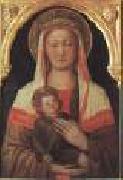 |
BELLINI, Jacopo
|
|
Italian Gothic Era Painter, ca.1400-1470
Born in Venice, Jacopo had been a pupil of Gentile da Fabriano. In 1411-1412 he was in Foligno, where with Gentile he worked at the Palazzo Trinci frescoes. In 1423 Bellini was in Florence, where he knew the new works by Brunelleschi, Donatello and Masaccio.
In 1424 he opened a workshop in Venice, which he ran right up until his death.
Many of his greatest works, including the enormous Crucifixion in the cathedral of Verona (1436), have disappeared. From c. 1430 is the panel with Madonna and Child, in the Accademia Carrara, once attributed to Gentile da Fabriano. In 1441, at Ferrara, where he was at the service of Leonello d'Este together with Leon Battista Alberti, he executed a portrait of that Marquess, now lost. Of this period the Madonna dell'Umilt??, probably commissioned by one of the brothers of Leonello.
The influence from Masolino da Panicale towards more modern, early Renaissance themes is visible in the Madonna with Child (dated 1448) in the Pinacoteca di Brera: for the first time, perspective is present and the figure are more monumental. Later he contributed with works now lost to the Venetian churches of San Giovanni Evangelista (1452) and St. Mark (1466). From 1459 is a Madonna with Blessing Child in the Gallerie dell'Accademia.
Later he sojourned in Padua, where he trained a young Andrea Mantegna in perspective and classicist themes and where, in 1460, he finished a portrait of Erasmo Gattamelata, now lost. Of his late phase, a ruined Crucifix in the Museum of Verona and an Annunciation in Sant'Alessandro of Brescia remain. |
|
|
|
|
|
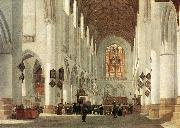 |
BERCKHEYDE, Job Adriaensz
|
|
Dutch painter (b. 1630, Haarlem, d. 1693, Haarlem).
He was apprenticed on 2 November 1644 to Jacob Willemsz. de Wet, whose influence is apparent in his first dated canvas, Christ Preaching to the Children (1661; Schwerin, Staatl. Mus.), one of the few biblical scenes in his oeuvre. On 10 June 1653 he repaid a loan from the Haarlem Guild of St Luke, which he subsequently joined on 10 March 1654. During his stay in Heidelberg, Job painted portraits and hunting scenes at the court of the Elector Palatine, who rewarded him with a gold chain, perhaps the one he wears in his early Self-portrait (c. 1655; Haarlem, Frans Halsmus.), his only documented work from the 1650s. Job is better known for his later work, which consists mainly of interior views of St Bavo's church in Haarlem and simple genre scenes recalling those of his Haarlem contemporaries Adriaen van Ostade and Jan Steen.
|
|
|
|
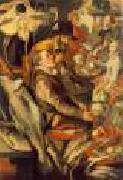 |
BEUCKELAER, Joachim
|
|
Flemish Northern Renaissance Painter, ca.1534-1574
A native of Antwerp, he studied under his uncle, Pieter Aertsen. Many of his paintings contain scenes of kitchen and markets, with religious allusions in the background. His Four Elements series (as of 2004[update], in the National Gallery, London) exemplifies this theme on a large scale. Water, for example, shows a fish market selling twelve kinds of fish, representing the twelve disciples of Jesus. Through an archway in the background we can see Jesus walking on the Sea of Galilee after his resurrection, making fish appear miraculously in empty nets. Beuckelaer's work was influential on painters in Northern Italy, particularly Vincenzo Campi. |
|
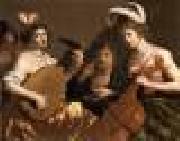 |
BIJLERT, Jan van
|
|
Dutch painter, Utrecht school (b. 1597/98, Utrecht, d. 1671, Utrecht)
Dutch painter. He was the son of the Utrecht glass painter Herman Beerntsz. van Bijlert (c. 1566-before 1615). Jan must have trained first with his father but was later apprenticed to the painter Abraham Bloemaert. After his initial training, he visited France and travelled to Italy, as did other artists from Utrecht. Jan stayed mainly in Rome, where he became a member of the Schildersbent; he returned to Utrecht in 1624. In Rome he and the other Utrecht artists had come under the influence of the work of Caravaggio; after their return home, this group of painters, who became known as the UTRECHT CARAVAGGISTI, adapted the style of Caravaggio to their own local idiom. The Caravaggesque style, evident in van Bijlert's early paintings. |
|
|
|
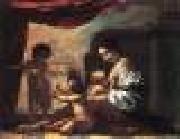 |
BLANCHARD, Jacques
|
|
French Baroque Era Painter, 1600-1638
He trained with his maternal uncle Nicolas Bollery (c. 1550/60-1630) from 1613 to 1618. He then set off for Italy but stopped at Lyon to work in the studio of Horace Le Blanc. Le Blanc left for Paris in 1623, and Blanchard is known to have finished a number of his works left in Lyon, including perhaps the Virgin and Child with a Bishop and a Woman Holding a Baby (Lyon, St Denis). At the end of October 1624 he reached Rome in the company of his brother Jean Blanchard, remaining there until April or May 1626. He was then in Venice until 1628, when he returned to Lyon via Turin. |
|
|
|
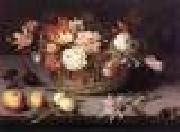 |
BOSSCHAERT, Johannes
|
|
Flemish painter (b. ca. 1610, Middelburg, d. ca. 1650, Utrecht)
was a member of the Bosschaert family of still life painters. He was the second son of Ambrosius Bosschaert. Little is known about his life, including the date of his death. |
|
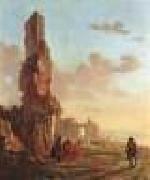 |
BOTH, Jan
|
|
Dutch painter (b. ca. 1618, Utrecht, d. 1652, Utrecht
Brother of Andries Both. He was one of the foremost painters among the second generation of DUTCH ITALIANATES. While working in Italy he specialized in genre scenes; however, on his return to the Netherlands he concentrated on wooded landscapes bathed in a golden light that illuminates the highly detailed foliage and trees. These realistic landscapes represent his most original contribution to Dutch painting and were much imitated by his contemporaries and by later artists. |
|
|
|
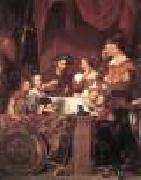 |
BRAY, Jan de
|
|
Dutch Baroque Era Painter, ca.1627-1697
Painter, draughtsman and etcher, son of Salomon de Bray. He spent virtually the whole of his career in Haarlem, except for the period 1686-8, when he lived in Amsterdam. After training with his father, Jan began working as a portrait painter in Haarlem in 1650, an activity he continued for the next 40 years. Between 1667 and 1684 he served on the committee for the Haarlem Guild of St Luke, whose leading members he portrayed in a picture dated 1675 (Amsterdam, Rijksmus.) that includes a self-portrait (Jan is seen standing and drawing on the left). He married three times, in 1668, 1670 and 1672. His first two wives died a year after their marriage, his third two years afterwards, and in each case the death was followed by disputes over the inheritance. Jan's bankruptcy of 1689 may have been a result of one of the lawsuits. |
|
|
|
|
|
|
|
|
|
 |
Burne-Jones, Sir Edward Coley
|
|
British Pre-Raphaelite Painter, 1833-1898
English painter and decorative artist. He was the leading figure in the second phase of the Pre-Raphaelite movement. His paintings of subjects from medieval legend and Classical mythology and his designs for stained glass, tapestry and many other media played an important part in the Aesthetic Movement and the history of international Symbolism. |
|
|
|
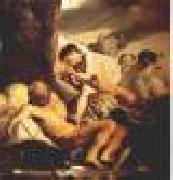 |
CAMPEN, Jacob van
|
|
Dutch Baroque Era Painter, 1595-1657
Chief exponent of Classicism in The Netherlands. He studied architecture in Italy and was influenced by the work of Scamozzi and Palladio. With his Coymans House on the Keizersgracht, Amsterdam (1624), he introduced the Palladian style to The Netherlands. His most refined work is the Mauritshuis in The Hague (1633?C5), which has a Palladian plan, elevations featuring a Giant Order of Ionic pilasters set on a plain base, a pedimented central section given little emphasis, and a hipped roof. Much grander is the Town Hall (now Royal Palace), Amsterdam (1648?C55): it has two internal courtyards separated by a huge central hall, façades with two superimposed Giant Orders of pilasters, and a large projecting pedimented central section over which is a domed lantern. His Nieuwe Kerk (New Church), Haarlem (1645?C9), is based on the quincunx plan (essentially a Greek cross within a square), with square Ionic crossing-piers and a groin-vault over the crossing. He was responsible for the Accijnshuis, Amsterdam (1638), the Noordeinde Palace, The Hague (1640), and, with others, the decorations of Post's Huis-den-Bosch, Maarssen, near Utrecht (c.1628). |
|
|
|
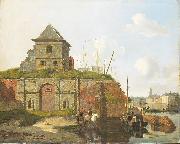 |
Carel Jacobus Behr
|
|
(9 July 1812 in The Hague - 11 November 1895) was a Dutch painter, watercolorist and draftsman. He was a pupil of Bartholomeus Johannes van Hove and mainly painted cityscapes, genre scenes and portraits.
In 1836 he produced, commissioned by The Hague municipal government, an image of the town hall there, which carried off the approval of connoisseurs. In 1837 he became a member of the Royal Academy in Amsterdam. His work is found in various collections and different exhibitions, like at the Hague in 1839, Rotterdam in 1840 and again at the Hague in 1841.
|
|
 |
Carl Johan Fahlcrantz
|
|
Swedish, 1774-1861, Swedish painter. He began his artistic training in Stockholm as a pupil of the theatre painters J. G. Brusell and E. Limnell (1764-1861). He also studied under the French landscape painter Louis Belanger (1736-1816). In 1805 he was awarded a scholarship to go to Italy, but he preferred to use it to travel within Sweden, as this corresponded more with his interest in painting his native landscape in a National Romantic style. Fahlcrantz settled permanently in Sweden, never travelling outside the Nordic countries. In 1819 he became a professor at the Royal Academy of Arts in Stockholm and in the 1820s Karl XIV commissioned a series of major works from him. Oscar I followed suit, as did numerous other buyers inside and outside Sweden. In this way, Fahlcrantz's paintings were distributed as far as Denmark, Bavaria, Russia and America. |
|
|
|
|
|
|
|
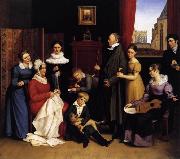 |
Carl Joseph Begas
|
|
Carl Joseph Begas (September 30, 1794 - November 24, 1854), was a German historical painter born at Heinsberg near Aachen. His father, a retired judge, destined him for the legal profession, but the boy's tastes pointed definitely in another direction. Even at school he was remarked for his wonderful skill in drawing and painting, and in 1812 he was permitted to visit Paris in order to perfect himself in his art.
He studied for eighteen months in the atelier of Antoine Jean Gros then began to work independently. In 1814 his copy of The Madonna della Sedia was bought by the king of Prussia, who was attracted by the young artist and did much to advance him. He was engaged to paint several large Biblical pictures, and in 1825, after his return from Italy, continued to produce paintings which were placed in the churches of Berlin and Potsdam. Some of these were historical pieces, but the majority were representations of Scriptural incidents. Begas was also celebrated as a portrait-painter, and supplied to the royal gallery a long series of portraits of eminent Prussian men of letters. At his death he held the post of court painter at Berlin.
|
|
|
|
 |
Casilear John William
|
|
American Hudson River School Painter, 1811-1893
was an American landscape artist belonging to the Hudson River School. Casilear was born in New York City. His first professional training was under prominent New York engraver Peter Maverick in the 1820s, then with Asher Durand, himself an engraver at the time. Casilear and Durand became friends, and both worked as engravers in New York through the 1830s. By the middle 1830s Durand had become interested in landscape painting through his friendship with Thomas Cole. Durand, in turn, drew Casilear's attention to painting. By 1840 Casilear's interest in art was sufficiently strong to accompany Durand, John Frederick Kensett, and artist Thomas P. Rossiter on a European trip during which they sketched scenes, visited art museums, and fostered their interest in painting. Casilear gradually developed his talent in landscape art, painting in the style that was later to become known as the Hudson River School. By the middle 1850s he had entirely ceased his engraving career in favor of painting full-time. He was elected a full member of the National Academy of Design in 1851, having been an associate member since 1831 |
|
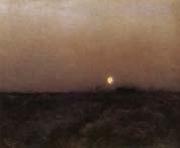 |
Cazin Jean-Charles
|
|
French landscapes painter and ceramist , 1841-Le Lavandou 1901
Painter and ceramicist. His earliest paintings reveal close affinities with the realist tradition, while his later compositions (mostly landscapes of northern France) demonstrate an awareness of Impressionism and a commitment to recording the changing effects of light and atmosphere. He was sent to England for health reasons but by 1862 or 1863 was living in Paris and active in avant-garde artistic circles. |
|
|
|
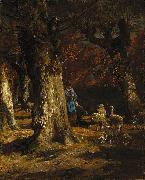 |
Charles Jacque
|
|
(23 May 1813 - 7 May 1894) was a French painter of animals (animalier) and engraver who was, with Jean-François Millet, part of the Barbizon School. He first learned to engrave maps when he spent seven years in the French Army.
Fleeing the Cholera epidemics that besieged Paris in the mid-nineteenth century, Charles Jacque relocated to Barbizon in 1849 with Millet. There, he painted rustic or pastoral subject matter: shepherds, flocks of sheep, pigs, and scenes of farm life. In addition to painting, Jacque was also famous for his etchings and engravings. He, along with Felix Bracquemond and Felix Buhot, is credited with the nineteenth-century revival of seventeenth-century techniques. He began his career as an engraver around 1841 by publishing a series of etchings with Louis Marvy. He followed this work with a serious of engravings based on the works of Adriaen van Ostade, after which he began to create original engravings / artworks. Charles Baudelaire said of him, "Mr. Jacque new reputation will continue to grow always, we hope. His etchings are very bold and his subject matter is well conceived. All that Mr. Jacque does on copper is filled with a freedom and a frankness which reminds one of the Old Masters. |
|
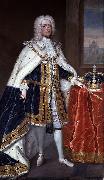 |
Charles Jervas
|
|
Charles Jervas (c. 1675 - 1739) was an Irish portrait painter, translator, and art collector of the early 18th century.
Born in County Offaly,Ireland around 1675, the son of John Jervas and Elizabeth, daughter of Captain John Baldwin of Shinrone Castle & Corolanty, High Sheriff of County Offaly. Jervas studied in London, England as an assistant under Sir Godfrey Kneller between 1694 and 1695.
After selling a series of small copies of the Raphael Cartoons circa 1698 to Dr. George Clarke of All Souls College, Oxford, the following year he travelled to Paris and Rome (while financially supported by Clarke and others) remaining there for most of the decade before returning to London in 1709 where he found success as a portrait painter. |
|
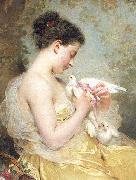 |
Charles Joshua Chaplin
|
|
(8 June 1825 - 30 January 1891) was a French painter and engraver. He was born in Les Andelys, Eure, France to an English father and a French mother. Although he spent the whole of his life in France, he only became naturalized in 1886. He died in Paris, France.
Chaplin conducted art classes specifically for women at his studio. The American artist Mary Cassatt and the English artist Louise Jopling were among Chaplin's students. |
|
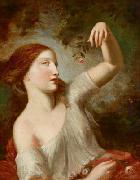 |
Charles-Joseph Natoire
|
|
(3 March 1700 - 23 August 1777) was a French painter in the Rococo manner, a pupil of François Lemoyne and director of the French Academy in Rome, 1751-1775. Considered during his lifetime the equal of François Boucher, he played a prominent role in the artistic life of France.
He is remembered above all for the series of the History of Psyche for Germain Boffrand's oval salon de la Princesse in the Hôtel de Soubise, Paris, and for the tapestry cartoons for the series of the History of Don Quixote, woven at the Beauvais tapestry manufacture, most of which are at the Château de Compiegne.
|
|
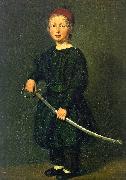 |
Christian Albrecht Jensen
|
|
1792-1870
Danish
Christian Albrecht Jensen Galleries
1792-1870
Danish
Christian Albrecht Jensen Galleries
was a Danish painter, born in Bredstedt, Nordfriesland. In 1818, he traveled to Rome, and met the sculptor Bertel Thorvaldsen. His work is representative of the Golden Age of Danish Painting.
|
|
|
|
|
|
|
|
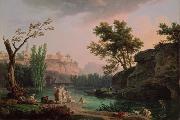 |
Claude Joseph Vernet
|
|
Claude-Joseph Vernet (14 August 1714 - 3 December 1789) was a French painter. His son, Antoine Charles Horace Vernet, was also a painter.
Vernet was born in Avignon. When only fourteen years of age he aided his father, Antoine Vernet (1689-1753),[1] a skilled decorative painter, in the most important parts of his work. The panels of sedan chairs, however, could not satisfy his ambition, and Vernet started for Rome. The sight of the sea at Marseilles and his voyage thence to Civitavecchia (Papal States' main port on the Tyrrhenian Sea) made a deep impression on him, and immediately after his arrival he entered the studio of a marine painter, Bernardino Fergioni.
Slowly Vernet attracted notice in the artistic milieu of Rome. With a certain conventionality in design, proper to his day, he allied the results of constant and honest observation of natural effects of atmosphere, which he rendered with unusual pictorial art. Perhaps no painter of landscapes or sea-pieces has ever made the human figure so completely a part of the scene depicted or so important a factor in his design. In this respect he was heavily influenced by Giovanni Paolo Panini, whom he probably met and worked with in Rome. Vernet's work draws on natural themes, but in a way that is neither sentimental or emotive. The overall effect of his style is wholly decorative.[2] "Others may know better", he said, with just pride, "how to paint the sky, the earth, the ocean; no one knows better than I how to paint a picture". His style remained relatively static throughout his life. His works' attentiveness to atmospheric effects is combined with a sense of harmony that is reminiscent of Claude Lorrain. |
|
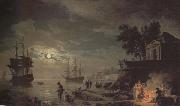 |
Claude-joseph Vernet
|
|
French Painter, 1714-1789
Vernet probably received his first lessons in painting from his father, Antoine, who then encouraged him to move to the studio of Philippe Sauvan (1697-1792), the leading master in Avignon. Sauvan supplied altarpieces to local churches and decorative works and mythologies for grand houses in the area. After this apprenticeship Vernet worked in Aix-en-Provence with the decorative painter Jacques Viali ( fl 1681- 1745), who also painted landscapes and marine pictures. In 1731 Vernet independently produced a suite of decorative overdoors for the h?tel of the Marquise de Simiane at Aix-en-Provence; at least two of these survive (in situ) and are Vernet's earliest datable landscapes. These are early indications of his favoured type of subject, and Vernet would have studied works attributed to such 17th-century masters as Claude Lorrain, Gaspard Dughet and Salvator Rosa in private collections at Aix and Avignon. Three years later Joseph de Seytres, Marquis de Caumont, who had previously recommended Vernet to the Marquise de Simiane, offered to sponsor a trip to Italy. |
|
|
|
|
|
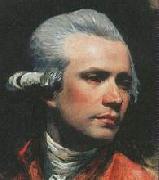 |
COPLEY, John Singleton
|
|
American Colonial Era Painter, 1738-1815
American portrait painter, b. Boston. Copley is considered the greatest of the American old masters. He studied with his stepfather, Peter Pelham, and undoubtedly frequented the studios of Smibert and Feke. At 20 he was already a successful portrait painter with a mature style remarkable for its brilliance, clarity, and forthright characterization. In 1766 his Boy with the Squirrel was exhibited in London and won the admiration of Benjamin West, who urged him to come to England. However, he remained in America for eight years longer and worked in New York City and Philadelphia as well as in Boston. In 1774 Copley visited Italy and then settled in London, where he spent the remainder of his life, enjoying many honors and the patronage of a distinguished clientele. In England his style gained in subtlety and polish but lost most of the vigor and individuality of his early work. He continued to paint portraits but enlarged his repertoire to include the enormous historical paintings that constituted the chief basis of his fame abroad. His large historical painting The Death of Lord Chatham (Tate Gall., London) gained him admittance to the Royal Academy. His rendering of a contemporary disaster, Brook Watson and the Shark (Mus. of Fine Arts, Boston), stands as a unique forerunner of romantic horror painting. Today Copley's reputation rests largely upon his early American portraits, which are treasured not only for their splendid pictorial qualities but also as the most powerful graphic record of their time and place. Portraits such as those of Nicholas Boylston and Mrs. Thomas Boylston (Harvard), Daniel Hubbard (Art Inst., Chicago), Governor Mifflin and Mrs. Mifflin (Historical Society of Pennsylvania, Philadelphia), and Paul Revere (Mus. of Fine Arts, Boston) are priceless documents in which the life of a whole society seems mirrored.
|
|
 |
Cornelis Janssens van Ceulen
|
|
(also Cornelius Jonson van Ceulen, Cornelius Johnson, Cornelis Jansz. van Ceulen and many other variants)(bapt. October 14, 1593, London - bur. August 5, 1661, Utrecht) was an English painter of portraits of Dutch or Flemish parentage. He has been described as "one of the most gifted and prolific portrait painters practising in England during the 1620s and 1630s".
Janssens van Ceulen was born to Dutch or Flemish parents in London - his father had been a refugee from Antwerp, and the family had originated in Cologne. He was baptised at the Dutch church at Austin Friars, the son of Johanna le Grand and Cornelius Johnson. He may have been trained in the Netherlands, and was certainly influenced by other artists from the Netherlands, but he was active in England, at least from 1618 to 1643. In the 1620s, he lived and had his studio in Blackfriars, London, as did Anthony van Dyck; it was just outside the boundaries of the City of London, and so avoided the monopoly in the City of members of the London painters' Guild. He married Elizabeth Beke of Colchester in 1622. Janssens' son (Cornelius Janssens, junior) was born in 1634. He was also a painter. Janssens' daughter was married to Nicholas Russell of Bruges. Janssens moved to Canterbury in the mid 1630s, living with Sir Arnold Braems, a Flemish merchant. Janssens continued to live in England until after the outbreak of the English Civil War, but in October 1643, apparently at the insistence of his wife, he moved to Middelburg, and between 1646 and 1652 he lived in Amsterdam, before settling in Utrecht, where he was buried. |
|
|

